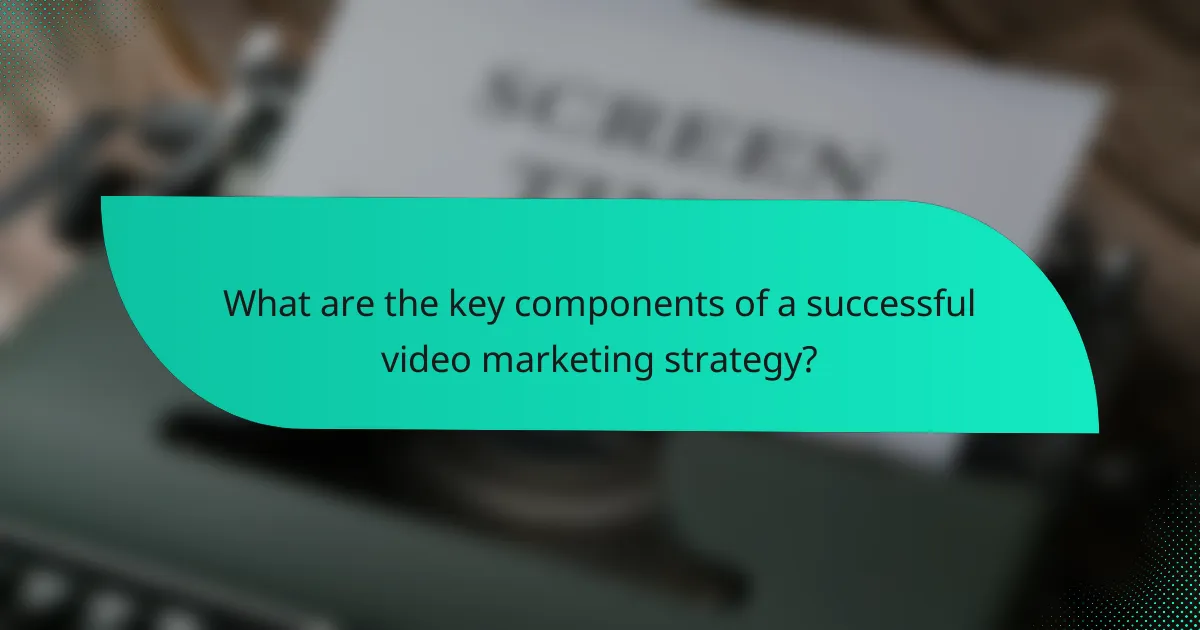Video marketing campaigns have emerged as a vital strategy for brands aiming to boost engagement and connect with their audience. By leveraging high engagement rates, compelling storytelling, and versatile formats, marketers can create impactful content that resonates with viewers. Understanding the right techniques and formats is essential for maximizing the effectiveness of these campaigns.

How to create effective video marketing campaigns in the UK?
Creating effective video marketing campaigns in the UK involves understanding your audience, employing engaging storytelling techniques, and selecting the right video formats. By focusing on these elements, you can enhance viewer engagement and drive better results.
Define target audience
Identifying your target audience is crucial for tailoring your video marketing campaigns. Consider demographics such as age, gender, location, and interests to create content that resonates with viewers. For instance, a campaign aimed at young adults may focus on trends and social issues relevant to that age group.
Utilize tools like surveys and social media analytics to gather insights about your audience’s preferences. This data will help you craft videos that speak directly to their needs and desires, increasing the likelihood of engagement.
Choose engaging storytelling techniques
Effective storytelling is key to capturing and retaining viewer attention. Use techniques such as relatable characters, emotional arcs, and conflict resolution to create a narrative that resonates. For example, a brand story that highlights customer success can foster a deeper connection with the audience.
Incorporate visual elements and sound design to enhance the storytelling experience. A well-crafted video that evokes emotions can lead to higher engagement rates, making your campaign more memorable.
Select versatile video formats
Choosing the right video format can significantly impact the effectiveness of your campaign. Options include explainer videos, testimonials, live streams, and short-form content for platforms like TikTok. Each format serves different purposes and can engage audiences in unique ways.
Consider the platform where your video will be shared. For instance, longer, in-depth videos may perform well on YouTube, while quick, attention-grabbing clips are better suited for Instagram or Facebook. Tailoring your format to the platform maximizes reach and engagement.
Utilize social media platforms
Social media is a powerful tool for distributing video content and engaging with your audience. Platforms like Facebook, Instagram, and LinkedIn allow you to share videos and interact with viewers through comments and shares. Leverage these platforms to boost visibility and encourage audience participation.
Consider running targeted ads on social media to reach specific demographics. Paid promotions can significantly increase your video’s reach, ensuring it gets in front of the right audience for maximum impact.
Measure engagement metrics
Tracking engagement metrics is essential for evaluating the success of your video marketing campaigns. Key metrics include views, likes, shares, comments, and watch time. Analyzing these figures helps you understand what resonates with your audience and informs future campaigns.
Utilize analytics tools provided by social media platforms and video hosting sites to gather data. Regularly reviewing these metrics allows you to adapt your strategies, ensuring continuous improvement in engagement and effectiveness.

What are the benefits of video marketing campaigns?
Video marketing campaigns offer numerous advantages, including high engagement rates, enhanced storytelling potential, and increased conversion rates. These benefits make video a powerful tool for brands looking to connect with their audience effectively.
High engagement rates
Video content typically garners higher engagement rates compared to other formats. Viewers are more likely to watch a video to completion, which can lead to increased shares and interactions on social media platforms.
To maximize engagement, consider using eye-catching thumbnails and compelling titles. Shorter videos, ideally under two minutes, often perform better as they cater to the audience’s limited attention span.
Enhanced brand storytelling
Video marketing allows brands to convey their stories in a dynamic and visually appealing way. Through visuals, sound, and narrative, companies can create emotional connections with their audience, making their messages more memorable.
Utilize storytelling techniques such as character development and conflict resolution to engage viewers. For example, a brand can showcase customer testimonials or behind-the-scenes footage to humanize its image and build trust.
Increased conversion rates
Implementing video in marketing strategies can lead to higher conversion rates. Studies suggest that including a video on landing pages can boost conversions by a significant percentage, as it helps clarify product benefits and features.
To enhance conversions, incorporate clear calls to action within the video. Ensure that the content addresses potential customer pain points and demonstrates how your product or service provides solutions.

Which video formats are most effective for campaigns?
Effective video formats for campaigns include short-form videos, live streaming events, and animated explainer videos. Each format offers unique advantages that can enhance engagement and storytelling potential, making them versatile tools for marketers.
Short-form videos
Short-form videos, typically lasting under two minutes, are highly effective for capturing attention quickly. Platforms like TikTok and Instagram Reels thrive on this format, allowing brands to convey messages succinctly and creatively.
To maximize impact, focus on strong visuals and a clear call to action within the first few seconds. Avoid lengthy introductions; instead, get straight to the point to maintain viewer interest.
Live streaming events
Live streaming events create real-time engagement opportunities, allowing brands to interact directly with their audience. This format is ideal for product launches, Q&A sessions, or behind-the-scenes content, fostering a sense of community and urgency.
Ensure you promote the event in advance and encourage audience participation through comments and questions. Consider using platforms like YouTube Live or Facebook Live, which are popular for their broad reach and user-friendly interfaces.
Animated explainer videos
Animated explainer videos simplify complex concepts, making them accessible and engaging. These videos can range from simple animations to more detailed storytelling, effectively illustrating a product’s features or benefits.
When creating animated videos, focus on clarity and pacing. Use a script that highlights key points and maintains viewer interest. Platforms like Vimeo and YouTube are excellent for hosting these videos, allowing for easy sharing and embedding.

What are the key components of a successful video marketing strategy?
A successful video marketing strategy includes clear objectives, compelling content, and effective distribution tactics. These components work together to engage audiences and drive desired actions, ultimately enhancing brand visibility and conversion rates.
Clear objectives and goals
Establishing clear objectives and goals is essential for any video marketing strategy. These should be specific, measurable, achievable, relevant, and time-bound (SMART). For example, a goal might be to increase brand awareness by 30% within six months through video content.
Consider what you want to achieve with your videos. Whether it’s boosting website traffic, generating leads, or increasing social media engagement, having defined goals will guide your content creation and measurement efforts.
Compelling content creation
Creating compelling content is crucial for capturing and retaining viewer attention. Focus on storytelling that resonates with your target audience, using relatable characters and scenarios. High-quality visuals and sound also enhance the overall impact of your videos.
Utilize various formats such as tutorials, testimonials, or behind-the-scenes looks to keep content fresh and engaging. Aim to keep videos concise, ideally under two minutes, to maintain viewer interest and encourage sharing.
Distribution and promotion tactics
Effective distribution and promotion tactics are vital for maximizing the reach of your video content. Identify the platforms where your audience spends their time, such as YouTube, Facebook, or Instagram, and tailor your content accordingly. Each platform has unique features that can enhance engagement.
Consider using paid advertising to boost visibility, especially for key campaigns. Monitor performance metrics like views, shares, and conversion rates to refine your strategy and ensure your videos are achieving their intended goals.

How to measure the success of video marketing campaigns?
To measure the success of video marketing campaigns, focus on key performance indicators (KPIs) such as view count, engagement rate, and conversion metrics. These metrics provide insights into how well your videos resonate with your audience and drive desired actions.
Key performance indicators (KPIs)
Key performance indicators for video marketing include metrics like views, likes, shares, comments, and watch time. Tracking these KPIs helps assess audience engagement and content effectiveness. For example, a high view count paired with significant engagement suggests that the video is appealing and relevant.
Engagement metrics
Engagement metrics are crucial for understanding how viewers interact with your video content. Look for metrics such as average watch time and click-through rates. A good rule of thumb is to aim for an average watch time that is at least 50% of the video’s total length, indicating that viewers find the content compelling.
Conversion rates
Conversion rates measure how effectively your video drives viewers to take specific actions, such as signing up for a newsletter or making a purchase. To calculate conversion rates, divide the number of conversions by the total number of views. A conversion rate of 2-5% is generally considered effective for video campaigns.
Tools for measurement
Utilize analytics tools like Google Analytics, YouTube Analytics, or social media insights to track video performance. These platforms provide detailed reports on viewer behavior and demographics. Regularly reviewing these analytics allows for timely adjustments to improve future video marketing strategies.
